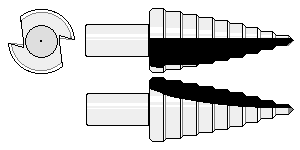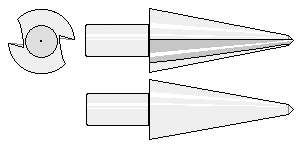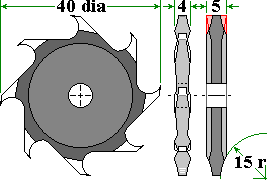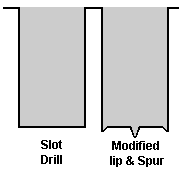
Cutting Tools
(Was Bradrad Multi Diameter Drill)
Various cutting tools used in beekeeping equipment manufacture are shown here, many have been adapted from other standard uses.

Originally part of the engineers toolkit intended for cutting different sized holes in sheet metal and deburring the hole in the same operation.
This cutter, when used in wood, produces stepped, tapered, holes that can prove very useful in making beekeeping gadgets. The stages in the one illustrated are 4, 6, 8, 10, 12, 14, 16, 18, 20 mm, but other types exist that have different step lengths and diameters.

There is a similar cutting tool that has a continuous taper rather than steps and this is known as a "cone cut"(shown right). I have also used these for various beekeeping purposes as well as the 'rose head' countersinking and counter boring cutters below.

Profiled Cutter which can drill the hole, provide clearance for the shank and countersink to accept the screw head, all in one operation.

The rose head bit is the conventional method of making a countersink recess, but I have used them for grooving and "fielding" panels as well.

This grooving cutter was developed for producing foundation grooves in top bars. It started life as a plain 5 mm wide grooving cutter as shown at extreme right.
To modify it I mounted it on a spindle and placed it in the chuck of a lathe and fitted a die grinder onto the slide. The 30 mm grinding wheel was spun at 10,000 rpm and gradually traversed into contact with the spinning cutter. The tip width was reduced to 2 mm and as a result of removing the material the cutter ended up 4 mm wide at it's maximum thickness and of the profile shown in the inner right view. For ease of drawing the cutter is shown with eight teeth, but the actual cutter has nine teeth at 40° intervals.

Some parts require blind borings to accommodate the ends of 4 mm diameter rods. These borings are best made using a drilling jig and a pillar drill that incorporates a depth stop.
The 4 mm drill bit should be ground to cut like a "slot drill" so as to give a flat bottom to the boring. If such grinding facilities do not exist a 4 mm "lip and spur" drill can be re ground to reduce the lips and the spur point, so as to produce a recess that is shaped like the cross section shown in the drawing at right.
All of the various cutting tools shown on this page can be kept in best cutting form by re sharpening using oilstones,
slip stones or a Diamond Hone.
Dave Cushman.
Page created pre-2011
Page updated 04/12/2022





